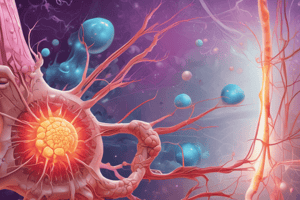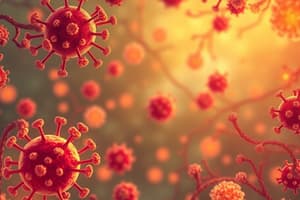Podcast
Questions and Answers
What is the usual outcome when the injury is limited or short-lived?
What is the usual outcome when the injury is limited or short-lived?
- Extensive destruction of the tissue
- Chronic inflammation
- Healing by connective tissue replacement
- Resolution (correct)
What happens when there is substantial tissue destruction?
What happens when there is substantial tissue destruction?
- Resolution occurs
- Chronic inflammation develops
- Healing by connective tissue replacement (correct)
- Tissue regeneration is rapid
What is the result of the persistence of the injurious agent or some interferences in the normal healing process?
What is the result of the persistence of the injurious agent or some interferences in the normal healing process?
- Healing by connective tissue replacement
- Acute to chronic transition (correct)
- Resolution
- Tissue regeneration
What happens when the inflammatory injury involves tissues that are incapable of regeneration?
What happens when the inflammatory injury involves tissues that are incapable of regeneration?
What is the primary advantage of performing an autopsy of Virchow?
What is the primary advantage of performing an autopsy of Virchow?
What is the process of removing the exudate with the restoration of normal tissue architecture?
What is the process of removing the exudate with the restoration of normal tissue architecture?
What can occur when there is abundant fibrin exudation in the tissue or even in serous cavities?
What can occur when there is abundant fibrin exudation in the tissue or even in serous cavities?
What type of incision is commonly used for an aesthetic finish?
What type of incision is commonly used for an aesthetic finish?
What is the main disadvantage of performing an autopsy of Virchow?
What is the main disadvantage of performing an autopsy of Virchow?
In what type of cases is the T-Shaped Incision essential?
In what type of cases is the T-Shaped Incision essential?
What is the advantage of performing an autopsy of Letulle?
What is the advantage of performing an autopsy of Letulle?
What type of incision is commonly used for children?
What type of incision is commonly used for children?
What role do TNF and IL-1 play in acute inflammation?
What role do TNF and IL-1 play in acute inflammation?
What is the primary function of chemokines in acute inflammation?
What is the primary function of chemokines in acute inflammation?
What is the result of the activation of complement proteins?
What is the result of the activation of complement proteins?
What is the characteristic of chronic inflammation?
What is the characteristic of chronic inflammation?
Which of the following is a cause of chronic inflammation?
Which of the following is a cause of chronic inflammation?
What type of cells are primarily responsible for secreting chemokines?
What type of cells are primarily responsible for secreting chemokines?
What is the main reason for the accumulation of leukocytes and the liberation of enzymes from those cells?
What is the main reason for the accumulation of leukocytes and the liberation of enzymes from those cells?
What is the characteristic appearance of Caseous Necrosis?
What is the characteristic appearance of Caseous Necrosis?
What type of necrosis is typically caused by arterial occlusion?
What type of necrosis is typically caused by arterial occlusion?
What is the result of the conversion of destroyed cells in Caseous Necrosis?
What is the result of the conversion of destroyed cells in Caseous Necrosis?
What is the term used to describe the massive death of tissue caused by a combination of ischemia and superimposed bacterial infection?
What is the term used to describe the massive death of tissue caused by a combination of ischemia and superimposed bacterial infection?
In which location is gangrenous necrosis most often encountered?
In which location is gangrenous necrosis most often encountered?
What is a common characteristic among genetic derangements that can cause cell injury?
What is a common characteristic among genetic derangements that can cause cell injury?
Which of the following is an example of an infectious agent that can cause cell injury?
Which of the following is an example of an infectious agent that can cause cell injury?
What is the result of genetic defects that can trigger cell death?
What is the result of genetic defects that can trigger cell death?
Which of the following is an example of an environmental pollutant that can cause cell injury?
Which of the following is an example of an environmental pollutant that can cause cell injury?
What is the term for the immune reactions that cause cell injury?
What is the term for the immune reactions that cause cell injury?
What is the result of nutritional imbalances that can cause cell injury?
What is the result of nutritional imbalances that can cause cell injury?
Flashcards are hidden until you start studying




